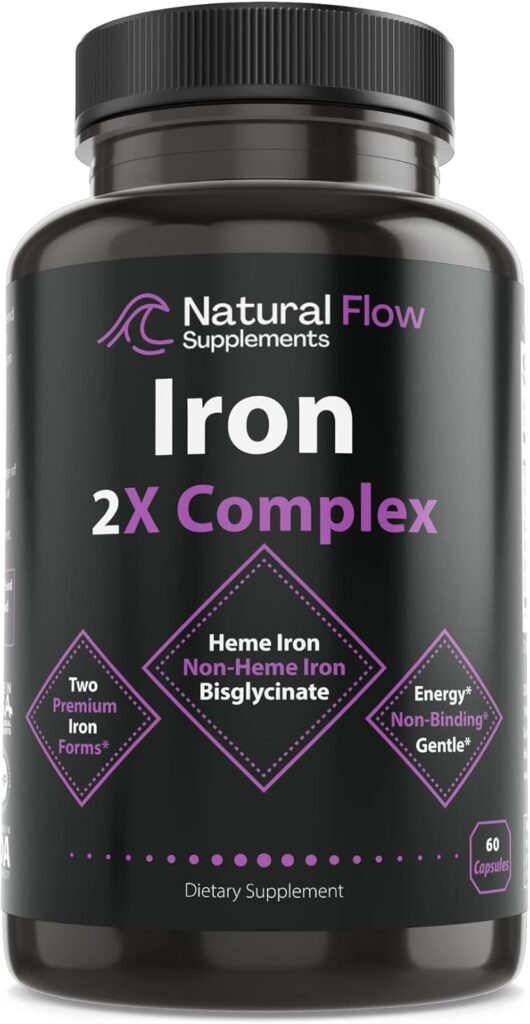Anemia is a common condition that occurs when your body doesn’t have enough healthy red blood cells to carry oxygen to your tissues.
This can leave you feeling fatigued, weak, or lightheaded, and it can affect your overall energy levels, focus, and immune system.
While there are many causes of anemia, one of the most common is iron deficiency.
Building a diet rich in iron is one of the most effective ways to support your body and improve symptoms naturally.
And in this post, we will explore 5 ways to build a high iron diet for anemia, starting with what causes anemia.
Let’s dive in!
What Causes Anemia?
Anemia can be caused by a variety of factors, but iron deficiency is the most common.
Iron is essential for producing hemoglobin, the protein in red blood cells that carries oxygen throughout your body.
A diet lacking in iron, chronic blood loss, or certain medical conditions can reduce iron levels, leading to symptoms like fatigue, pale skin, dizziness, and shortness of breath.
In addition to iron, deficiencies in vitamin B12, folate, and other nutrients can also contribute to anemia.
5 Ways to Build a High Iron Diet for Anemia
1. Iron Supplement Complex
Taking a high-quality iron supplement can help replenish your body’s iron stores quickly.
Look for supplements that combine both heme and non-heme iron forms for optimal absorption.
As an added bonus, look for iron supplements that include B6 and folate, which support red blood cell production and overall anemia support.
Supplements are especially useful if dietary intake alone isn’t enough to meet your needs.
Out of all of the iron supplements I’ve tried, Natural Flow’s Iron 2x Complex is my personal favorite.
Natural Flow’s Iron is my favorite because it combines both heme and non-heme iron for maximum absorption, ensuring your body gets the iron it truly needs.
It also includes a solid amount of Vitamin B6 and folate, which support healthy red blood cell production and overall anemia support.
Unlike many iron supplements, it’s gentle on the stomach, so you can take it daily without nausea or discomfort.
Simply take one capsule per day and you’re good to go!
2. Include Lean Red Meats
Lean red meats like beef and lamb are excellent sources of heme iron, the type of iron your body absorbs most efficiently.
Incorporating these into your meals a few times per week can make a significant difference in maintaining healthy iron levels.
Pairing meat with vitamin C-rich foods can further enhance absorption.
3. Eat Iron-Rich Plant Foods
Vegetables, legumes, nuts, and seeds are great sources of non-heme iron.
Spinach, lentils, chickpeas, pumpkin seeds, and quinoa are all excellent options.
While non-heme iron isn’t absorbed as efficiently as heme iron, combining these foods with vitamin C-rich fruits like oranges or bell peppers can improve absorption.
4. Cook with Cast Iron
Cooking in a cast-iron skillet can naturally increase the iron content of your food.
Foods like tomato sauces, soups, and stir-fries absorb iron from the cookware, giving you an extra boost with each meal.
This is an easy and inexpensive way to support your daily iron intake.
5. Limit Iron Blockers Around Meals
Certain foods and beverages can interfere with iron absorption if consumed in large amounts with meals.
Tea, coffee, and high-calcium dairy can reduce iron uptake, so it’s best to enjoy them between meals rather than alongside iron-rich foods.
Being mindful of these combinations can help maximize the benefits of your high-iron diet.
Building Your High-Iron Diet
Supporting your body with a high-iron diet is one of the most natural and effective ways to manage anemia.
By combining iron-rich foods, supplements, smart cooking techniques, and awareness of absorption inhibitors, you can help your body maintain healthy red blood cell levels and improve overall energy and wellness.
Start incorporating these strategies today and give your body the nutrients it needs to thrive.
Thank you for reading!
Affiliate Disclosure
Some of the links on this site are affiliate links. This means that if you click on the link and purchase the item, we may receive an affiliate commission at no extra cost to you. I only recommend products or services that I believe will add value to my readers, however, some (not all) do pay us to be on this blog. Your support and theirs help keep this blog running, and I genuinely appreciate it.
Medical Disclaimer
The information provided on this website is for educational purposes only and is not intended as medical advice. This blog or the writer is not a licensed healthcare professional, and the content should not be used as a substitute for professional medical diagnosis, treatment, or advice. Always consult with your physician or other qualified healthcare provider before starting any new treatment or making any changes to your healthcare routine.
